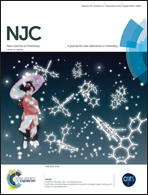Fabrication of copper sulfide using a Cu-based metal organic framework for the colorimetric determination and the efficient removal of Hg2+ in aqueous solutions†
Abstract
CuS (PCuS) particles were facilely synthesized by the wet-treatment of a Cu-based metal organic framework (HKUST-1). PCuS possesses an impressive intrinsic peroxidase-like activity. As a result of this affinity, PCuS readily binds to 3,3′,5′,5-tetramethylbenzidine (TMB) in the presence of hydrogen peroxide (H2O2) (Km values of 29 μM and 150 μM toward TMB and H2O2, respectively). Interestingly, when Hg2+ was added, HgS produced in conjunction with the specific binding sites on the surface of PCuS remarkably inhibited the peroxidase-like activity of PCuS. Based on this unique property, a sensing platform for the colorimetric detection of Hg2+ was established. In addition, high surface area and strong affinity for Hg2+ make PCuS an excellent adsorbent for Hg2+ (2105 mg g−1). These results indicate that PCuS could be a useful material for the facile detection and the efficient removal of Hg2+ using HKUST-1 as a precursor in environmental abatement applications.


 Please wait while we load your content...
Please wait while we load your content...